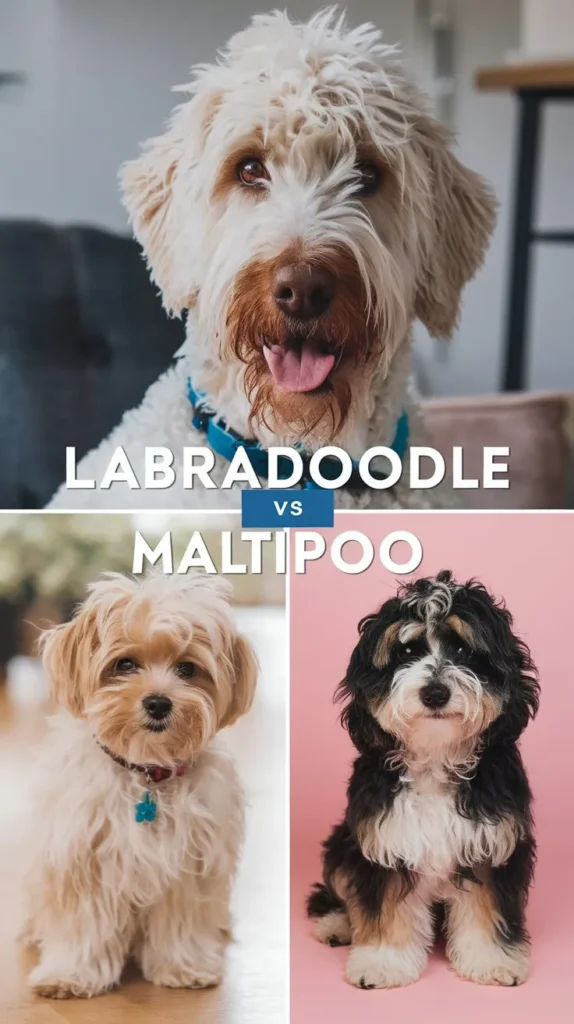Labradoodle Vs Maltipoo: Which Breed is More Intelligent, Loyal, and Loving?
As you weigh the pros and cons of bringing a new furry friend into your life, you’re likely considering two popular hybrid breeds: Labradoodles and Maltipoos. Both are charming, intelligent, and loving companions, but which one is the best fit for you?
While they share some similarities, these breeds have distinct differences in their origins, physical characteristics, and needs.
From their coat types to exercise requirements, understanding these nuances is vital for providing the right care and attention. So, what sets these breeds apart, and which one will capture your heart?
In a Nutshell

- Labradoodles are larger, weighing 50-65 pounds, while Maltipoos are smaller, weighing 4-8 pounds.
- Labradoodles have a low-shedding, curly coat, while Maltipoos have a silky, smooth coat prone to matting.
- Labradoodles require more exercise and mental stimulation, needing 30-45 minutes of daily walks, whereas Maltipoos need 15-30 minutes.
- Both breeds are prone to genetic health issues, with Labradoodles susceptible to hip dysplasia and Maltipoos to hypoglycemia.
Origin and History

When exploring the roots of these popular crossbreeds, you’ll discover that the Labradoodle originated in the 1980s, while the Maltipoo‘s history dates back to the 1990s.
The breeding intentions behind these hybrids were to create a dog that combined the best traits of their purebred parents.
The Labradoodle’s ancestral roots can be traced back to Wally Conron, an Australian breeder who aimed to develop a guide dog with low-shedding characteristics. He crossed a Labrador Retriever with a Poodle, resulting in a intelligent, friendly, and hypoallergenic dog.
On the other hand, the Maltipoo’s breeding intentions were to create a small, affectionate companion dog that inherited the Maltese’s gentle nature and the Poodle’s intelligence.
Their ancestral roots stem from breeding Maltese and Poodle breeds to produce a dog with a low-shedding coat and a loving personality.
Understanding the origins and history of these breeds can help you appreciate their unique characteristics and make an informed decision when choosing a pet.
Physical Characteristics

As you examine the physical characteristics of Labradoodles and Maltipoos, you’ll notice distinct differences in their size, coat, and body type, which directly result from their unique parent breeds.
Labradoodles, being a cross between a Labrador Retriever and a Poodle, tend to be larger, with an average weight range of 50-65 pounds and a height of 18-22 inches.
Maltipoos, on the other hand, are a combination of a Maltese and a Poodle, resulting in a smaller build, with an average weight range of 4-8 pounds and a height of 8-12 inches.
When it comes to their coats, you’ll find significant fur texture differences between the two breeds.
Labradoodles often inherit the Poodle’s low-shedding, curly coat, which can range from soft and wavy to tight and spiral.
Maltipoos, with their Maltese heritage, tend to have a silky, smooth coat that’s prone to matting.
Body shape variations are also apparent, with Labradoodles typically having a more athletic build and Maltipoos having a compact, toy-like physique.
These physical characteristics will give you a better understanding of which breed suits your lifestyle and preferences.
Grooming Needs Compared

You’ll need to contemplate the grooming demands of Labradoodles and Maltipoos, which differ substantially due to their distinct coat types and textures.
Labradoodles have a thick, curly or wavy coat that sheds moderately, requiring regular brushing to prevent matting.
Maltipoos, on the other hand, have a soft, silky coat that sheds minimally, making them a great choice for those with allergies.
When it comes to coat texture differences, Labradoodles tend to have a coarser coat, while Maltipoos have a finer, more delicate coat.
This affects their grooming needs, as Labradoodles require more frequent brushing to prevent tangling, whereas Maltipoos need gentle, occasional brushing to maintain their coat’s softness.
In terms of shedding frequency comparison, Labradoodles shed more frequently than Maltipoos, especially during seasonal changes.
Maltipoos, being low-shedding dogs, are ideal for those who want to minimize dog hair in their homes.
Understanding these differences will help you decide which breed is better suited to your lifestyle and grooming preferences.
Temperament and Trainability

When it comes to temperament and trainability, you’ll find that Labradoodles and Maltipoos have distinct characteristics that impact their learning styles.
You’ll need to weigh the training approaches that work best for each breed, as they respond differently to positive reinforcement and correction.
Training Style Differences
How do your training methods need to adapt to the distinct temperaments of Labradoodles and Maltipoos, given their unique breed characteristics and genetic influences? As you set out on training your new companion, understanding their individual needs is crucial and respond accordingly.
| Breed | Training Style |
|---|---|
| Labradoodle | Positive reinforcement, Consistent routine, and clear boundaries. They thrive on structure and clear communication. |
| Maltipoo | Gentle, patient training with positive reinforcement. They respond well to calm, gentle guidance and consistent rewards. |
Socialization Needs Vary
Given their distinct temperaments and genetic influences, Labradoodles and Maltipoos have varying socialization needs that require tailored approaches to help them develop into confident, well-adjusted companions. As you consider bringing one of these breeds into your life, comprehending their unique socialization requirements is vital.
When it comes to social skills development, you’ll need to adapt your approach to each breed’s specific needs.
Labradoodles, with their outgoing and friendly nature, benefit from early exposure to various environments, people, and experiences. This helps them develop confidence and adaptability.
Maltipoos, on the other hand, have a shorter socialization window, requiring gentle, positive interactions during their critical development periods.
Both breeds require consistent, patient socialization to overcome potential fears and anxieties.
Reward-based training and positive reinforcement are crucial for developing good social skills in both Labradoodles and Maltipoos.
Energy Levels and Exercise

Do you find yourself wondering whether a Labradoodle or Maltipoo can keep up with your active lifestyle, or whether they’ll be content with a leisurely stroll around the block? Both breeds require regular exercise to stay happy and healthy, but their energy levels differ. Here’s a breakdown of their exercise needs:
| Breed | Daily Walks | Playtime Routines | Exercise Level |
|---|---|---|---|
| Labradoodle | 30-45 minutes | 1-2 hours of play | High to Very High |
| Maltipoo | 15-30 minutes | 30-60 minutes of play | Moderate to High |
| Both | Consistent routine | Mental stimulation | Vital for mental health |
| Both | Adapt to your schedule | Adjust intensity and duration | As they age or gain maturity |
| Both | Provide exercise variety | Avoid boredom and stagnation | Through play, walks, and training |
As you can see, Labradoodles require more intense exercise, while Maltipoos need regular, shorter walks and playtime. Both breeds benefit from a consistent routine, mental stimulation, and exercise variety to prevent boredom and stagnation.
By understanding their energy levels and exercise needs, you can create a tailored plan that suits your lifestyle and guarantees your furry friend stays happy and healthy.
Health Issues and Lifespan

When pondering a Labradoodle or Maltipoo as a pet, you’ll want to familiarize yourself with their potential health issues.
Both breeds have genetic predispositions that can affect their quality of life, and understanding these risks is crucial to provide the best care possible.
You’ll need to weigh the average lifespan of each breed, as well as the health problems they’re prone to, to make an informed decision.
Genetic Predispositions
You’ll want to ponder the genetic predispositions of Labradoodles and Maltipoos, as both breeds are prone to specific health issues that can affect their lifespan.
As a responsible pet owner, verifying the genetic diversity concerns and inherited trait risks associated with these breeds is crucial.
When it comes to Labradoodles, you should be aware of the following genetic predispositions:
Hip dysplasia: A common issue in Labradors, which can lead to arthritis and mobility problems.
Eye problems: Labradoodles can inherit eye issues like progressive retinal atrophy and cataracts from their Labrador Retriever parent.
Allergies: Both Labradors and Poodles can pass on allergy issues to their offspring, making skin problems and ear infections more likely.
Obesity: Labradoodles can inherit a tendency to overeat from their Labrador parent, leading to obesity and related health issues.
Understanding these genetic predispositions can help you take proactive steps to guarantee your pet leads a healthy, happy life.
Average Lifespan
As you consider the genetic predispositions of Labradoodles, it’s also important to understand how these health issues can impact their average lifespan.
On average, Labradoodles can live between 12 to 15 years, but this can vary depending on several longevity factors.
For instance, the size of the Labradoodle plays a significant role in determining its lifespan. Miniature Labradoodles tend to live longer than standard Labradoodles, with an average lifespan of 14 to 16 years.
Additionally, breed specific mortality rates also come into play. For example, Labradoodles are more prone to hip dysplasia, which can affect their lifespan if left untreated.
In contrast, Maltipoos have an average lifespan of 10 to 13 years.
However, with proper care and attention to health issues, some Maltipoos have been known to live up to 15 years or more.
To guarantee a long and healthy life, you must work with a reputable breeder who prioritizes the health and well-being of their puppies, thereby certifying you’re getting a pet with a long and healthy life ahead of it.
Family and Social Dynamics

Both Labradoodles and Maltipoos thrive in families with children, but their temperaments and energy levels differ, making one more suitable for busy households and the other for families seeking a more laid-back companion.
When it comes to family dynamics, you’ll want to weigh how these breeds interact with your children.
Sibling rivalries: Labradoodles tend to be more energetic and playful, which can lead to sibling rivalries if not managed properly. Maltipoos, on the other hand, are generally more laid-back and gentle, making them a better fit for families with younger children.
Family harmony: Labradoodles require more exercise and stimulation to prevent destructive behavior, while Maltipoos are happy with shorter, more gentle play sessions.
Socialization: Both breeds require early socialization to prevent anxiety and fear-based behaviors, but Labradoodles may need more consistent training and reinforcement.
Noise levels: If you have a loud household, a Maltipoo may be a better fit, as they’re more sensitive to noise and chaos.
Ultimately, the choice between a Labradoodle and a Maltipoo comes down to your family’s unique needs and lifestyle.
Space and Living Requirements

Considering your living situation is crucial when deciding between a Labradoodle and a Maltipoo, since these breeds have distinct space and exercise requirements that can greatly impact their overall well-being. As you weigh your options, think about the type of living space you can provide for your future pet.
| Breed | Space Requirements | Exercise Needs |
|---|---|---|
| Labradoodle | Medium to large homes with yards | Daily walks and playtime, occasional runs |
| Maltipoo | Small to medium homes, apartments | Short daily walks, playtime, and occasional playdates |
| Both | Urban dwellings with access to outdoor spaces | Regular exercise to prevent boredom and destructive behavior |
| Both | Owners with active lifestyles or willingness to provide regular exercise | Ideal for owners who can commit to regular physical activity with their pet |
If you live in an urban dwelling, a Maltipoo might be a better fit, as they require less space and exercise. However, if you have a larger home with a yard and are willing to provide regular exercise, a Labradoodle could thrive.
Regardless of the breed, it is imperative to provide access to outdoor spaces and commit to regular exercise to safeguard your pet’s overall well-being.
Cost and Maintenance

You’ll also need to factor in the financial and time commitments required to care for a Labradoodle or Maltipoo, as their grooming, feeding, and health needs can substantially impact your budget and daily routine.
These costs can add up quickly, so it’s crucial to weigh them thoroughly before bringing a new pet into your home.
Food and treats: High-quality dog food and treats can cost between $50 to $75 per month, depending on the size and breed of your dog.
Grooming: Regular grooming sessions can cost around $30 to $90 per session, depending on the frequency and type of grooming needed.
Pet insurance costs: Pet insurance can range from $20 to $50 per month, depending on the age, breed, and health of your dog.
Veterinary care expenses: Regular veterinary check-ups, vaccinations, and potential health issues can add up to $500 to $1,000 per year.
Frequently Asked Questions
Can Labradoodles and Maltipoos Be Left Alone During the Workday?
When you’re away at work, your dog may develop separation anxiety, exhibiting lonely behaviors like barking, chewing, or digging. To prevent this, establish a consistent morning routine, provide mental stimulation, and consider crate training or dog walkers.
Do Labradoodles and Maltipoos Make Good Therapy Dogs?
You’ll find that many breeds, including Labradoodles and Maltipoos, make excellent therapy dogs due to their exceptional social skills and ability to form strong emotional connections with people, providing comfort and affection.
Can Labradoodles and Maltipoos Be Trained for Agility Activities?
You can train your dog for agility activities by building strong agility foundations, introducing them to obstacle courses, and gradually increasing difficulty levels, allowing them to develop speed, agility, and confidence.
Are Labradoodles and Maltipoos Prone to Destructive Behavior?
You’ll find that any puppy, regardless of breed, can develop destructive behavior if not socialized properly, as boredom triggers unwanted habits; invest time in training and exercise to prevent this outcome.
Do Labradoodles and Maltipoos Get Along With Other Pets?
You’re wondering if your new furry friend will get along with others? Generally, socialized dogs thrive in pet harmony, forming strong furry friendships with other pets, especially when introduced gradually and with positive reinforcement training.












Hi, I’m Ella Frost, a devoted animal lover working at CuddlyCreatureCare.com. My passion for animals drives me to share my knowledge through comprehensive guides on animal care and rescue. I’m here to help you understand and care for your furry friends better.







